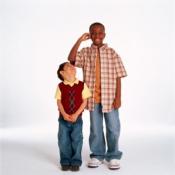 There are four types of human beings, and I believe each is designed to attend to at least one of four critical areas of need in a functioning human society.
There are four types of human beings, and I believe each is designed to attend to at least one of four critical areas of need in a functioning human society.
The tasks that each temperament is designed to attend to are so disparate that significant differences in perceptions, priorities, values, and meanings are required to attend to them. These automatically triggered differences are present at birth, identifiable at an early age and, like the degree to which each newborn is left-, right-, or mixed-handed, will not change much across time.
For instance, a naturally literal parent will not be able to get their naturally possibilities-oriented child to become more literal, any more than a naturally feel-response-oriented parent will be able to get their natural thinking-response-oriented child to experience emotions more like a feeling-oriented individuals does.
The temperament that each child is born with may be the same as, or different from,
- One or both parents.
- One or more siblings.
- One or more extended family members.
- A teacher, coach, employer, friend, or therapist.
The nature of temperament-driven differences is such that four individuals with different temperaments can perceive, process, prioritize, and respond to the same reality in significantly different ways. Current models for making sense out of these differences treat them as matters of choice rather than of nature.
Consequently, when these differences lead to a disagreement over who is right and who is not, each assumes that the other is choosing to differ when they are not. Never-ending relationship-threatening debates can ensue driven by natural differences that neither is aware exist.
I have been providing my individual, couple, and family clients with information on natural differences in temperaments since 2000. Once most clients have realized that natural differences are at play, debilitating debates over who is right and who is not have come to an end. This allows for accommodation and compromise in areas that had not been possible before.
Taking a freeware version of the Myers-Briggs Type Indicator (MBTI) can identify an individual’s temperament. A two-letter code within the four-letter MBTI psychological type code identifies the temperament providing the driving force for that particular type. The method for identifying temperament codes is found at the end of this article.
The Four Temperaments
1. Sensing-Judging (SJ): Approximately 45% of the population
People with the SJ temperament provide structure for human societies. From an early age they want to know what the rules are—the societal norms for acceptable behavior. They will then live their life according to those rules and expect others to do the same.
With regards to typological wiring, choice is not an option. An SJ person’s sense of self is connected to following the rules and honoring the traditions of their society and they will automatically be bothered when others do not. Without SJs, human beings would not have a functioning foundation, a social order.
- Extraverted SJs are wired to express disapproval immediately when someone is breaking a rule. That unacceptable behavior might be cutting in line, arriving late for a meeting, or making too much noise in a library.
- Introverted SJs are also automatically bothered by such behaviors, but may not be as direct in expressing their disapproval.
The four SJ-driven personality types are ESTJ, ESFJ, and ISTJ. SJs of note include George Washington, Mother Teresa, Andy Rooney, Desmond Tutu, and Barbara Walters.
2. Sensing-Perceiving (SP): Approximately 23% of the population
People with SP temperaments are designed to address the needs of immediate sensory experience. The common denominator for SPs that distinguishes them from the other three temperaments is their need for freedom to respond or create in the moment, as the moment dictates, without reference to others.
This independence of mind is innate, a derivative of nature’s design and an essential requirement for the purpose and function they are designed to attend to. SJs tend to take care of the structural needs of human societies, that which can be predicted and planned out. Meanwhile, SPs are attending to the needs of the moment, those aspects of human experience that are best served by in-the-moment innovation and ingenuity.
SPs adapt to the constantly changing variables of immediate sensory experience. This can be quite extraordinary; SPs are found among the most gifted practitioners of both the fine as well as the martial arts.
The four SP-driven personality types are ESFP, ESTP, ISTP, and ISFP. SPs of note include Barbra Streisand, Erwin “Magic” Johnson, George C. Patton, Meryl Streep (my guess here), and Michael J. Fox.
3. Intuitive-Thinking (NT): Approximately 15% of the population
Those with NT temperaments are designed to process information from a logical frame of reference. Their primary function is to make sure that what is said or done makes logical sense. NTs can often be found in leadership roles in science, business, government, sports, and the military, making sure that logic rules the decision-making process.
In order to attend to their role responsibilities in a functioning human society, NTs are designed to experience emotions within objective parameters of cause and effect. As with the other three temperaments, choice is not an option. If something said or done does not make logical sense, it is automatically rejected as invalid.
The four NT-driven personality types are ENTJ, ENTP, INTJ, and INTP. Well known NTs include Hilary Clinton, Steve Jobs, Albert Einstein, General Colin Powell, and Angela Lansbury.
4. Intuitive-Feeling (NF): Approximately 18% of the population
NFs are designed to facilitate harmony in the lives of other human beings. Nature assures that NFs attend to their role of responsibility by triggering feelings of guilt and blame disproportionate to objective reality when they upset or disappoint someone or do not help others when they know they can help but may not want to.
A rule of thumb for NFs is, “If is not said nicely, it is not nice.” No other temperament is designed with this degree of guilt and blame sensitivity in their wiring. Given this innate set of priorities for experiencing a sense of meaning and purpose in life, it is not surprising that as many as 75% of marriage and family therapists in private practice are NFs.
The four NF-driven personality types are ENFJ, ENFP, INFJ, and INFP. Well-known individuals with the NF wiring include Oprah Winfrey, Abraham Maslow, Nelson Mandela, Mahatma Gandhi, and Isabel Briggs-Myers.
Procedure for Identifying Temperament
For a free short-form questionnaire to find your own temperament, you can go to www.NaturalPersonalityInstitute.com and download the freeware questionnaire (Natural Personality Questionnaire) based on the MBTI located there. Fill it in and score it. When done, you will have a four-letter psychological type code.
The first letter of that type’s temperament code is found on the Sensing-Intuition dichotomy. That is the second column from left on the questionnaire.
- If the first letter is S for Sensing, the second letter is found on the Judging-Perceiving dichotomy (the last, or fourth, column on the right).
- If your letter code on the Judging-Perceiving dichotomy is J for Judging, your temperament is SJ (Sensing-Judging).
- If your letter code is P for Perceiving, your temperament is SP (Sensing-Perceiving).
- If the first letter of your two letters temperament code is N for Intuition, the second letter is found on the Thinking-Feeling dichotomy (third column from left)
- If your letter code is T for Thinking, your temperament is NT (Intuitive-Thinking).
- If your letter is F for Feeling, your temperament is NF (Intuitive-Feeling).
For example, my four-letter MBTI psychological type code is INFP. The first letter of my temperament code is found on the Sensing-Intuition dichotomy which, in my case, is N for Intuition. When N is the first letter of a temperament code, the second letter is found on the Thinking-Feeling dichotomy which, in my case, is F for Feeling. Therefore my two-letter temperament code is NF for Intuitive-Feeling.
Between Temperament Communication
In order to maximize your effectiveness in navigating communication problems with temperaments that differ from your own it is helpful to remember the following:
- SJs automatically prioritize rules of conduct, if others are behaving appropriately.
- SPs automatically prioritize the dictates of immediate sensory experience.
- NTs automatically prioritize the logical consequences of an act or intention.
- NFs automatically prioritize how people may or will feel about what is said and done.
Choice is not an option. Like the degree to which each newborn is left, right, or mixed handed, the temperament in each newborn’s wiring is the temperament that will provide the perceptual frame of reference throughout their lifetime.
My mother and I provide a perfect example of this phenomenon. She was an ESTJ and I am an INFP, opposites on all four dichotomies. She was a thinking-response-oriented SJ and I am an NF. She was bluntly direct (and usually right!) in letting me know how I should be behaving.
I found her manner of communicating to be hurtful, leaving me feeling guilty, bad, and resentful. I kept her at an emotional distance most of my life. She was 93 and still cognitively sharp as a tack, before I got up the courage to tell her how her manner of communicating affected me.
She was genuinely surprised, stating, “Michael, I do not understand this guilt thing. I did not want you to feel bad about yourself; I just wanted you to do it right.” This comment helped me realize that thinking-oriented and feeling-oriented people naturally experience emotions very differently.
A Note of Caution
While the information on temperaments and temperament-specific psychological types tends to be accurate, it is general in nature, addressing response dynamics known to be common for individuals with each of the type profiles. The specifics of an individual’s self, separate from others, is far too complex to be captured by a temperament specific tendencies profile.
First of all, there are a near infinite number of degrees of response orientation that an individual may have on each of the four dichotomies known to determine an individual’s temperament and temperament specific psychological type. Birth order, degrees of visual, auditory, and kinesthetic perceptual processing, spirituality, aptitudes of mind, and a wide range of environmental influences, as well as an X factor to cover the inexplicable, also factor into the equation.
The complexity involved is such that true knowing of another has some very real limitations. Because of this, type profiles should be used for the gathering of general information about an individual, but most definitely not to define the person.

The preceding article was solely written by the author named above. Any views and opinions expressed are not necessarily shared by GoodTherapy.org. Questions or concerns about the preceding article can be directed to the author or posted as a comment below.

 Conflict and the Thinker/Feeler Struggle in Relationships
Conflict and the Thinker/Feeler Struggle in Relationships Find Your Authentic Self and You Just Might Find Your Next Career
Find Your Authentic Self and You Just Might Find Your Next Career Personality: Does Birth Order Matter?
Personality: Does Birth Order Matter?

Please fill out all required fields to submit your message.
Invalid Email Address.
Please confirm that you are human.
Leave a Comment
By commenting you acknowledge acceptance of GoodTherapy.org's Terms and Conditions of Use.